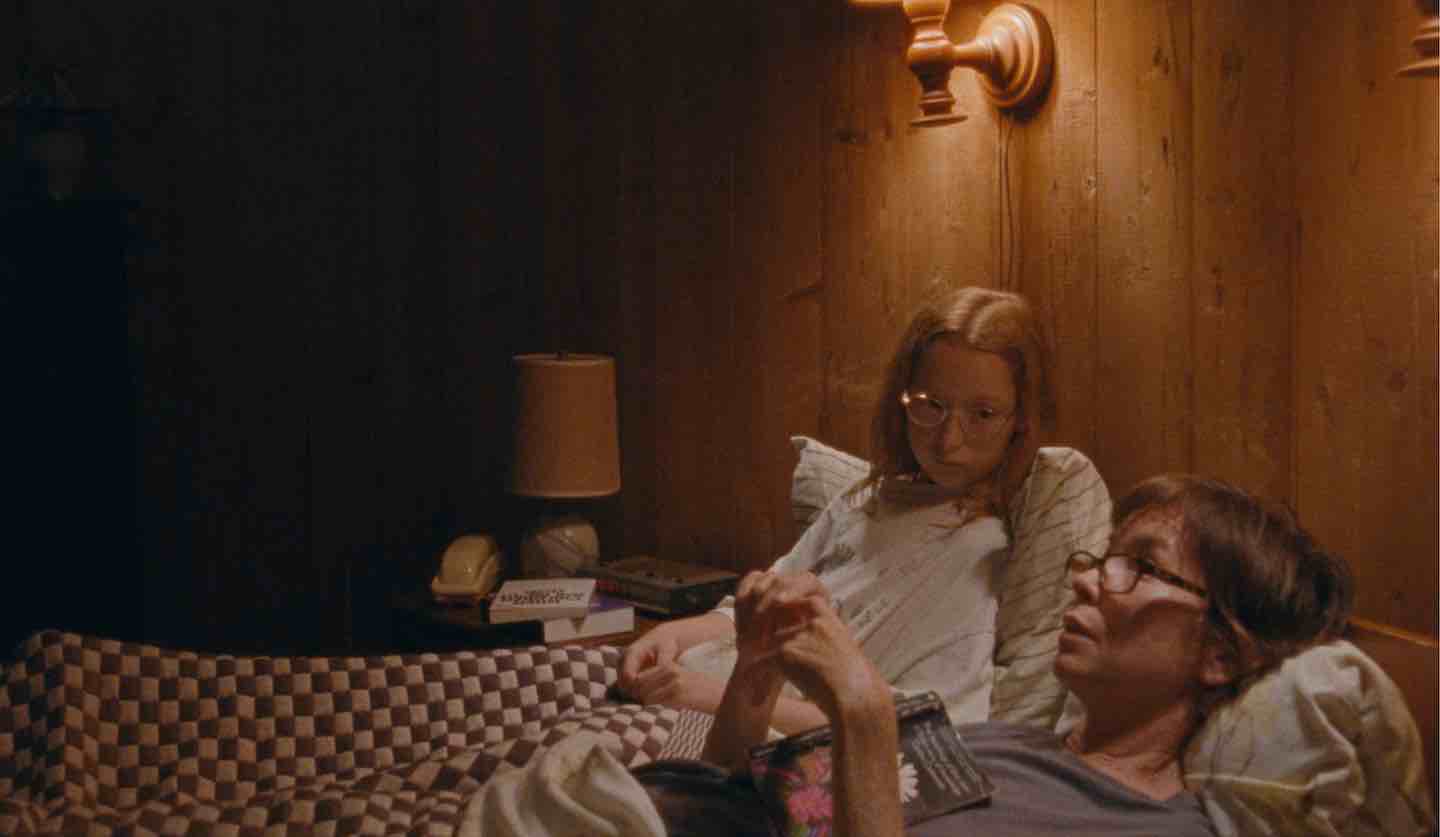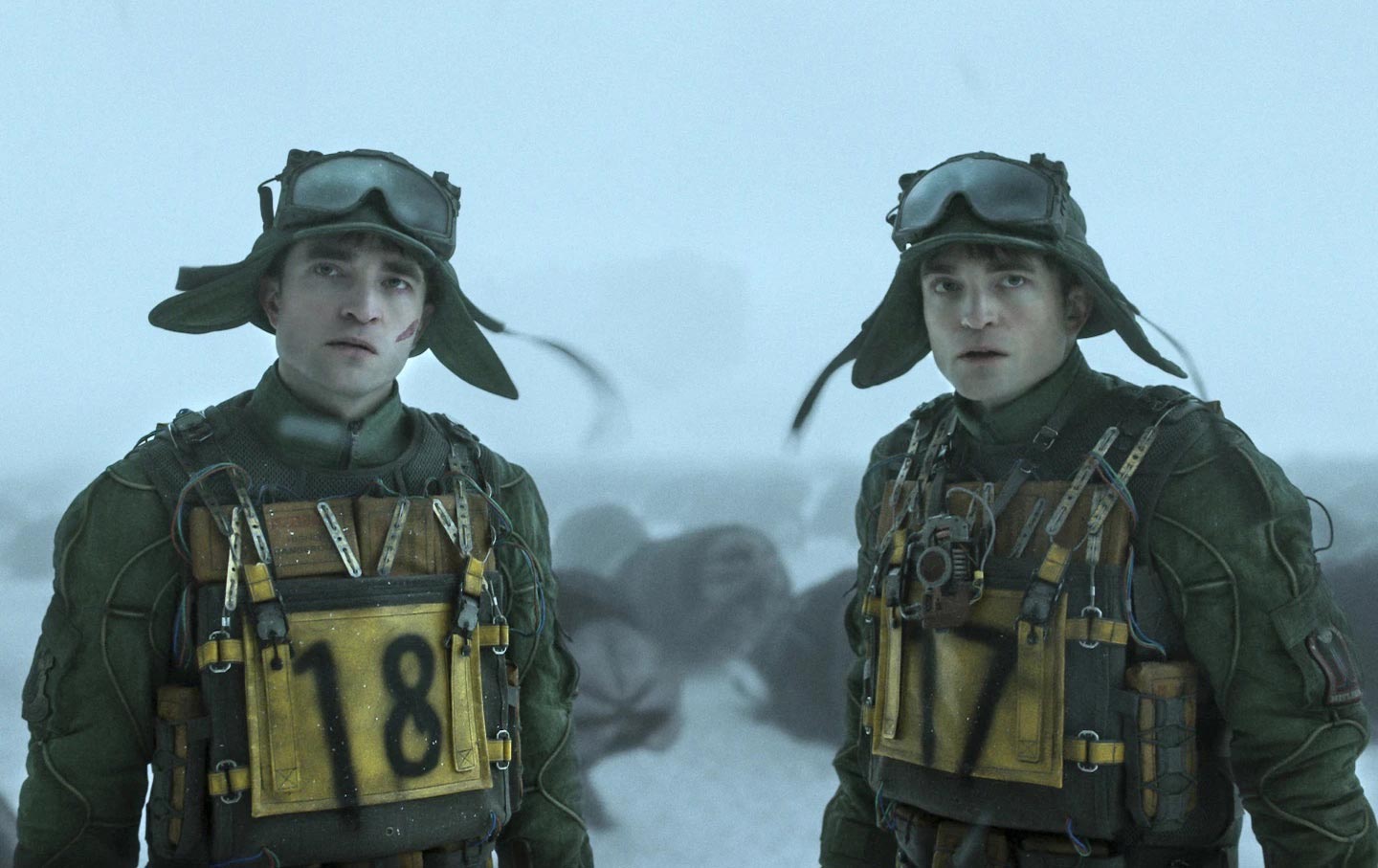Time, Space, and Annie Baker
The playwright’s remarkable debut film, Janet Planet, immerses the viewer in the sounds and sorrow of a middle-schooler’s endless summer.

At eye level, a microwave. A beep as the light comes on, then a mechanical whir. Behind the smudged door, a blintz is defrosting. Seconds pass by, almost a minute’s worth. We watch the inert thing inside change states imperceptibly. Another beep, and the light clicks off. It is done.
The blintz in question will be dinner for Lacy, an 11-year-old girl whose mother, Janet, has gone on a date, leaving her daughter alone in their home’s enfolding silence. As the camera’s patient gaze on the microwave might suggest, Lacy is in no particular hurry, having nothing to do and nowhere to be. Indeed, the preceding scenes of Janet Planet, the playwright Annie Baker’s quietly transcendent first film, have delineated the scant, open shape of the girl’s days during a languid summer break in western Massachusetts. She practices for her piano lessons, plodding through tinny scales on an electric keyboard. She tends to a mismatched assortment of dolls and figurines. She lies on the grass in the sun, awaiting the moment when Janet, who is an acupuncturist, appears at her studio door between clients. Once, she rides a bicycle slowly and deliberately down a series of dirt roads to get an ice cream cone. Perpetually unsmiling in an oversized T-shirt, she is nearly inert, subtly changing states.
The film’s tight parameters recall Baker’s plays, each of which takes place in a single location and treats the passage of time as an important medium. Baker has said in interviews that she often starts with a setting—in her words, “a container”—and proceeds toward a vision of bodies moving in four dimensions. Her best-known work, the Pulitzer Prize–winning The Flick (2013), unspools among the seats of a failing movie theater, while her most recent play, Infinite Life (2023), transpires on the patio of a dubious water-fasting clinic. In highly specific stage directions, she often details not only the choreography of an action but also its precise duration: The movie house’s employees sweep up spilled popcorn for at least 20 seconds, or the projector beams out inscrutable images for about two minutes. Time, and the unstable elasticity with which we experience it, is one of her preoccupations. In Infinite Life, the protagonist, a woman beset by mysterious chronic pain, breaks the fourth wall to record the progression of minutes and hours, highlighting the way the days stutter and slacken under the weight of her suffering. Janet Planet, too, considers a kind of time that refuses to march reliably forward, a season spent on the cusp of adolescence, when childhood is slipping away and what comes next is still out of view.
Of course, by shifting her meditations on time and attention to a new medium, Baker transforms the nature of her exploration. “Theater is an opportunity to experience time at the same rate as the actors in the story you’re watching,” she once told Bomb magazine. “Movies are an opportunity to travel back in time.” A character in The Flick makes a similar argument: “Film is light and shadow and it is the light and shadow that were there on the day you shot the film.” Film is a mode of preservation, in other words, and a method of declaring something worth remembering.
In Janet Planet (which, not incidentally, was shot in 16-millimeter), Baker travels back in time to 1991, when she would have been Lacy’s contemporary, and to Amherst, Massachusetts, the rural town where she herself was raised. She not only shot on location but painstakingly constructed a purely diegetic “score” from audio collected on the primary set’s forested property, sifting through hundreds of hours of bird calls and insect hum to decide, for example, “exactly when the woodpecker comes in during the dinner scene.” (Having grown up in this same setting, I experienced the precise fidelity of these sounds on what felt like a molecular level.) This commitment to verisimilitude constitutes an offering of devotion to a place and time usually deemed beneath notice: the outskirts of the Northeast Corridor at the end of history.
Baker’s work has always been marked by a sociological impulse and a subtle ear for regional subcultures, which she often turns on her native New England. In Circle Mirror Transformation (2009), the best of her four plays set in the fictional college town of Shirley, Vermont, she brings together a sharply observed cross section (aging hippies, a Brooklyn transplant, a blue-collar artisan) for a community theater class; in The Flick, which takes place in the depressed suburbs of central Mass, the movie theater’s three employees contrast their differing routes to the same dead-end job. Other plays are likewise set in way stations and backwaters, places where people get stuck on the way to what they thought their lives would be. Infinite Life’s sanatorium is awkwardly installed in a California strip mall, while John (2015) traps its cast in an old-fashioned and possibly haunted rural Pennsylvania B&B.
The effect of training our attention on all this stasis is to palpably dilate and sharpen it, much as our eyes might adjust in low light. In Janet Planet, this involves watching the characters retrace a closed loop—Janet cycling between romantic partners, Lacy following her own flat routine—as if convinced it will open at any moment onto transformation. (“Something is about to happen,” chants an actor in a gorgeously silly hippie theater piece that Lacy attends with Janet—a promise that a more conventional film makes to the audience, and that this one takes as a subject of inquiry but resolutely withholds.) In its experiment with monotony, the film picks up a particular feminist lineage, recalling the second-wave classic Jeanne Dielman, 23, quai du Commerce, 1080 Bruxelles (1975), a mostly wordless, more-than-three-hour-long chronicle of the domestic tasks—shopping, cooking, cleaning—that fill a widowed mother’s days. “When most people go to the movies, the ultimate compliment—for them—is to say, ‘We didn’t notice the time pass!’” the film’s writer and director, Chantal Akerman, famously said in 2004. “With me, you see the time pass. And feel it pass.” By making us not only look but work to keep seeing despite intense boredom, Akerman forcibly redistributes a form of value. Baker’s microwave shot may be less aggressive, but it asserts a similar claim on the viewer, immersing us in the existential tedium of its subject’s days.

In Janet Planet, attention is not only the artistic medium but the commodity that propels the slender plot. Lacy (played with incredible focus and stillness by first-time actor Zoe Ziegler) is insatiably hungry for Janet’s affection, while Janet (a fragile and luminous Julianne Nicholson) feels suffocated by Lacy’s unblinking scrutiny. Their story plays out in three acts, each revolving around a new relationship that draws mother away from daughter. At first, Lacy competes with Janet’s hostile boyfriend, Wayne, begging Janet to sleep in her bed instead of sharing his. Later, Janet takes in an old friend, Regina, and Lacy tries to insinuate herself into the women’s adult dynamic. When Janet is at last absorbed by a courtship with Avi, the charismatic founder of a nearby commune, Lacy responds with a resignation bordering on despair.
What Lacy is only beginning to recognize is that Janet is driven by her own thirst for affirmation, the result of a deep insecurity. “I know I’m not that beautiful, but I’ve always had this knowledge that I could make any man fall in love with me if I really tried,” Janet confesses to her preteen daughter after another breakup. “And I think maybe it’s ruined my life.” Lacy, radiating a loneliness that reads as an indictment of everyone around her, is, conversely, hard to love. (Janet tells her she has “an aggressive quality,” and Lacy herself explains to Regina that she doesn’t have a single friend.) In place of another form of appeal, Lacy finds a source of leverage in her unhappiness. “Do you want to know what’s funny? Every moment of my life is hell,” she says to Janet in another scene, with a note of triumph, before adding, “I don’t think it’ll last, though.”
Throughout, Baker dramatizes Lacy’s aching possessiveness with shots that delicately dismember their subjects: One scene lingers on the angle of Janet’s jaw as seen from the backseat of the car, while another takes in the tangle of Wayne and Janet’s feet in bed. In one standout moment, a trifold bathroom mirror produces a triptych of Janets, an inescapably sacramental image lit by a radiant fluorescent glow. (Appropriately, as Lacy washes up at this domestic altar, her mother is attempting to explain what a cult is. “They all worship someone,” she says.) The film’s camerawork, simultaneously intimate and defamiliarizing, conjures the kind of close looking that is unadulterated by habit, often associated with being a child, or being in love. Lacy is, effectively, both—a very young person flooded with new awareness, and a devotee of a monotheistic religion in which Janet gives and Janet takes away. Ultimately, the tunneling gaze of the film becomes a means of confronting the limitations of looking. No amount of noticing can give Lacy possession of Janet or make her into the companion her mother is searching for; no depth of attention can make the beloved speak, like a ventriloquist’s dummy, the words the lover needs to hear.
One could make the case that all of Baker’s work is somehow about loneliness and the unreachableness of the other. In a theater class exercise in Circle Mirror Transformation, two characters perform a scene in gibberish. Baker’s stage directions specify their attempt to confess their secrets through this string of sounds, and their belief that they’ve been understood when, of course, they haven’t. This is the fundamental condition of loving and being loved in a Baker production, which she mines for its comedy, its pathos, and, ultimately, the space it leaves open for a form of transcendence. In John, which follows a bitterly mismatched young couple during an ill-fated hotel stay, the characters describe the moments when they have touched a sense of cosmic security, what one describes as feeling temporarily “more alone but less lonely…less alone in my alone-ness.” This state is achieved through the ministrations of the material world, including the B&B’s salient collection of tchotchkes: People may be painfully imperfect witnesses, but objects, in John, are unerringly faithful ones—evoking the possibility of other “watchers,” such as us, the audience, or, perhaps, God.
In the extraordinary climax of Janet Planet, Janet and Lacy both find ways to be more alone but less lonely. Janet, during a picnic with Avi, finally acknowledges the oppressive power of Lacy’s attention. “Sometimes I feel like she’s watching me,” she admits, even when the two are physically apart. In response, Avi shares a passage of Rainer Maria Rilke’s devotional Duino Elegies, about the child’s need to turn their complex love for the parent toward a less impossible object, personified in the poem by a puppet on a stage. As Avi reads, Baker intercuts Janet at the picnic with Lacy in her bedroom, prostrating herself before the little diorama that holds her assemblage of dolls. Is she praying for Avi to disappear? Or for herself to no longer need him to? Either way, it seems clear that it is the stuff of this world—the trees and the seasons, the dolls and houses and furniture—that bears witness to us when our loved ones fail to do so. In Rilke’s elegy, the speaker stares at the puppets with such intensity that an angel arrives to bring them to life. Perhaps this implies the presence of a divine watcher, or it could suggest that it’s the force of Lacy’s gaze that animates the figurines to serve as her audience. In the end, Lacy’s turn toward a new set of onlookers allows Janet, at least briefly, to escape being watched. Alone in her car after an uncanny twist in the evening’s events, she bites into a drumstick with the total abandon of the truly unobserved.
As the film draws to a close, Lacy is still letting go of Janet. At a contra dance, she watches her mother spin ecstatically from partner to partner, a painful awareness dawning on her face. It’s a fitting end for a work that is loaded throughout with the apprehension of loss, attempting as it does to capture a world that no longer exists. A similar nostalgia seems to infuse Baker’s very approach to filmmaking. The Flick was, in part, an elegy for all that was lost in cinema’s transition to digital, and Janet Planet’s almost mystical commitment to the materiality of its medium implies an echo of the same lament. What’s more, one might read Lacy with her dolls as an artist finding her powers, suggesting that the creative impulse takes shape as a way to console us for our small griefs. It’s Baker’s preoccupation with loss that gives weight to her film’s exercises in looking: No matter how hard we stare, we can’t fix things fully in memory or keep them from changing, slipping away. Maybe this is why, in an understated visual motif, the camera often fixates on a figure’s departing back. Lacy runs down a hill, almost vanishing into the purple evening; a car drives down a road until the red dots of its tail lights grow small. The viewer looks after them, straining to see what is threatening, with each passing moment, to disappear.








